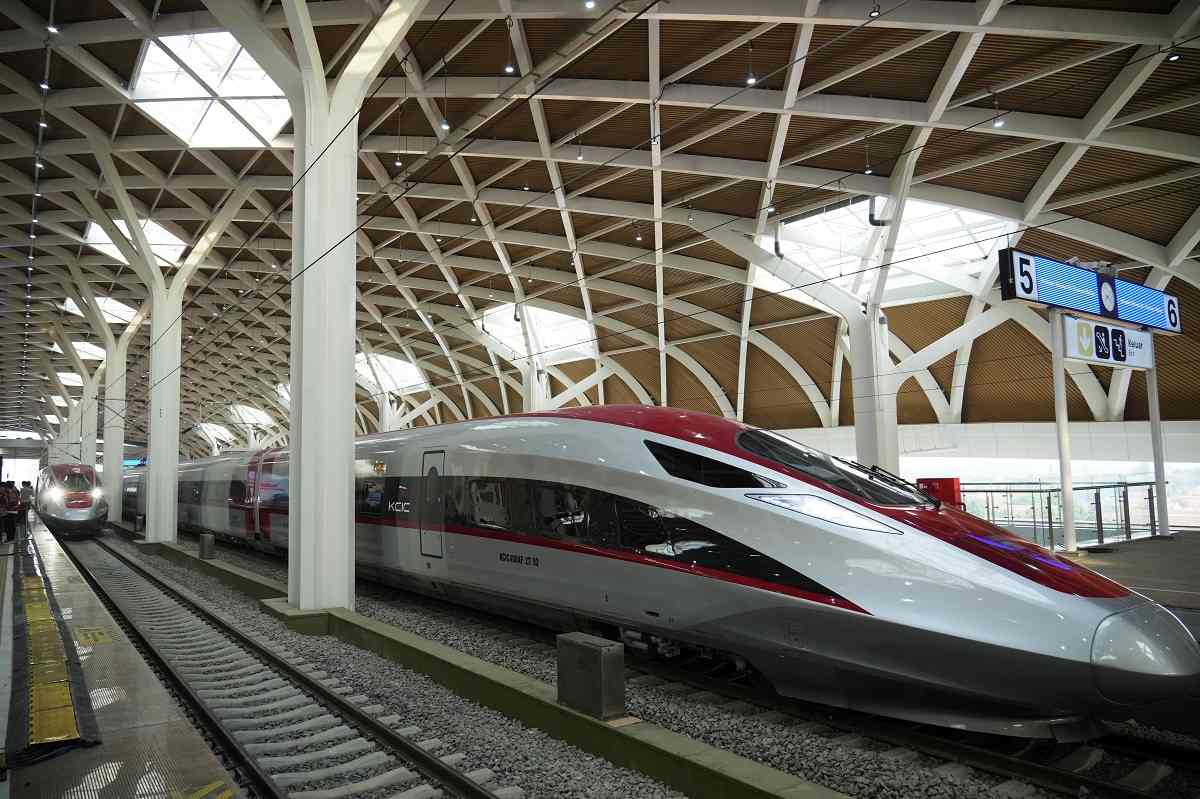Indonesian President Launches Southeast Asia’s First High-Speed Railway, Funded by China

High-speed train is parked during the opening ceremony for launching Southeast Asia’s first high-speed railway at Halim station in Jakarta, Indonesia, Monday, Oct. 2, 2023.
12:19 JST, October 3, 2023
JAKARTA, Indonesia (AP) — Indonesian President Joko Widodo inaugurated Southeast Asia’s first high-speed railway on Monday as it was set to begin commercial operations, a key project under China’s Belt and Road infrastructure initiative that will drastically reduce the travel time between two key cities.
The project has been beset with delays and increasing costs, and some observers doubt its commercial benefits. But Widodo has championed the 142-kilometer (88-mile) railway, which was issued its official operating license from the Transportation Ministry on Sunday.
The $7.3 billion project, largely funded by China, was constructed by PT Kereta Cepat Indonesia-China, known as PT KCIC, a joint venture between an Indonesian consortium of four state-owned companies and China Railway International Co. Ltd.
The railway connects Jakarta with Bandung, the heavily populated capital of West Java province, and will cut travel time between the cities from the current three hours to about 40 minutes.
Its use of electrical energy is expected to reduce carbon emissions.
Widodo in his opening remarks officially named Indonesia’s first high-speed railway — the fastest in Southeast Asia, with speeds of up to 350 kph (217 mph) — as “Whoosh,” from “Waktu Hemat, Operasi Optimal, Sistem Handal,” which means “timesaving, optimal operation, reliable system” in Indonesian language.
“The Jakarta-Bandung high-speed train marks the modernization of our mass transportation, which is efficient and environmentally friendly,” Widodo said.
“Our courage to try new things gives us confidence and the opportunity to learn and will be very useful for the future, making our human resources more advanced and our nation more independent,” he added.
Widodo, along with other high-ranking officials, rode Whoosh from its first station, Halim in eastern Jakarta, to Bandung’s Padalarang station, one of the line’s four stations, located about 30 kilometers (18 miles) from the central area of Bandung.
He took a 25-minute test ride on the train on Sept. 13 and told reporters that he felt comfortable sitting or walking inside the bullet train even at its top speeds.
Chinese Premier Li Qiang took a test ride early last month while visiting Jakarta for three days of talks with leaders of the Association of Southeast Asia Nations and other countries.
Luhut Binsar Pandjaitan, the coordinating minister for maritime and investment, said China Railway has agreed to transfer its technology to Indonesia so that in the future the country’s high-speed trains can be made domestically.
For two weeks leading up to the inauguration, PT KCIC has been running a free-of-charge public trial.
Indonesia broke ground on the project in 2016. The line was originally expected to begin operations in 2019, but was delayed by disputes over land acquisition, environmental issues and the COVID-19 pandemic. It was planned to cost 66.7 trillion rupiah ($4.3 billion), but the amount ballooned to 113 trillion rupiah ($7.3 billion).
The trains have been modified for Indonesia’s tropical climate and are equipped with a safety system that can respond to earthquakes, floods and other emergency conditions. The 209-meter (685-foot) train has a capacity of 601 passengers.
Ticket prices had not been finalized as of Monday, but PT KCIC estimated one-way prices per passenger would range from 250,000 rupiah ($16) for second class to 350,000 rupiah ($22.60) for VIP seats.
Passengers going to downtown Bandung need to take a feeder train from the Padalarang station that will add a further 20 minutes, with an estimated cost about 50,000 rupiah ($3.20).
The rail deal was signed in October 2015 after Indonesia selected China over Japan in fierce bidding. It was financed with a loan from the China Development Bank for 75% of the cost. The remaining 25% came from the consortium’s own funds.
The project is part of a planned 750-kilometer (466-mile) high-speed train line that would cut across four provinces on Indonesia’s main island of Java and end in the country’s second-largest city, Surabaya.
As a global economic giant, China is one of the largest sources of foreign direct investment in Southeast Asia, a region home to more than 675 million people. Amid crackdowns by the United States and its allies, China is expanding trade with ASEAN countries and infrastructure projects are playing key roles.
A semi-high-speed railway — with speeds up to 160 kph (99 mph) — linking China with Laos was inaugurated in December 2021. The $6 billion infrastructure was financed mostly by China under the Belt and Road policy. The 1,035-kilometer (643-mile) route runs through Laos’ mountain ranges to connect the southeastern Chinese city of Kunming with Vientiane, the capital of Laos. There are plans for a high-speed train down through Thailand and Malaysia to Singapore.
"News Services" POPULAR ARTICLE
-

American Playwright Jeremy O. Harris Arrested in Japan on Alleged Drug Smuggling
-

Japan’s Nikkei Stock Average as JGB Yields, Yen Rise on Rate-Hike Bets
-

Japan’s Nikkei Stock Average Licks Wounds after Selloff Sparked by BOJ Hike Bets (UPDATE 1)
-

Japan’s Nikkei Stock Average Buoyed by Stable Yen; SoftBank’s Slide Caps Gains (UPDATE 1)
-

Japanese Bond Yields Zoom, Stocks Slide as Rate Hike Looms
JN ACCESS RANKING
-

Keidanren Chairman Yoshinobu Tsutsui Visits Kashiwazaki-Kariwa Nuclear Power Plant; Inspects New Emergency Safety System
-

Imports of Rare Earths from China Facing Delays, May Be Caused by Deterioration of Japan-China Relations
-

University of Tokyo Professor Discusses Japanese Economic Security in Interview Ahead of Forum
-

Tokyo Economic Security Forum to Hold Inaugural Meeting Amid Tense Global Environment
-

Japan Pulls out of Vietnam Nuclear Project, Complicating Hanoi’s Power Plans


























